PROJ6011: Infrastructure Project Management - Identification Analysis
VerifiedAdded on 2023/06/04
|18
|4729
|178
Case Study
AI Summary
This document presents a case study focusing on integrated infrastructure project management, specifically examining an Indian Public-Private Partnership (PPP) procurement aimed at highway development. It covers various aspects including project demand, stakeholder benefits, environmental impact, and triple bottom line considerations. The study identifies key challenges such as land acquisition and resource maintenance, proposing solutions like customized agile project management and resource optimization. It also emphasizes the importance of stakeholder engagement through a stakeholder management system and analyzes effective attributes of PPPs. The document concludes with project leadership lessons learned, highlighting the significance of team communication, visualization, and effective meetings. Desklib provides this and other solved assignments to aid students in their studies.

Running head: INTEGRATED INFRASTRUCTURE PROJECT MANAGEMENT
Integrated Infrastructure Project Management
Name of the Student
Name of the University
Author Note
Integrated Infrastructure Project Management
Name of the Student
Name of the University
Author Note
Paraphrase This Document
Need a fresh take? Get an instant paraphrase of this document with our AI Paraphraser
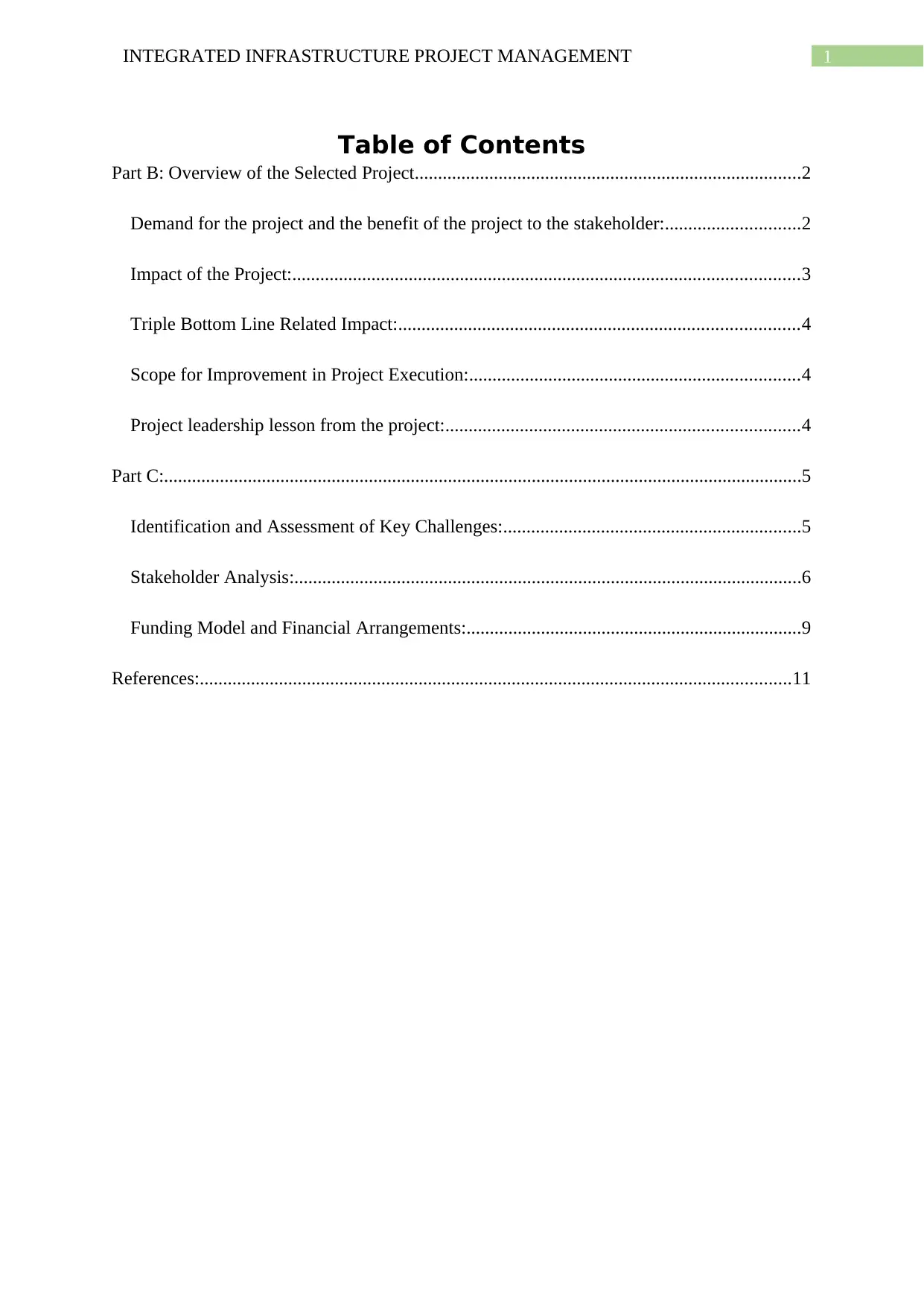
1INTEGRATED INFRASTRUCTURE PROJECT MANAGEMENT
Table of Contents
Part B: Overview of the Selected Project...................................................................................2
Demand for the project and the benefit of the project to the stakeholder:.............................2
Impact of the Project:.............................................................................................................3
Triple Bottom Line Related Impact:......................................................................................4
Scope for Improvement in Project Execution:.......................................................................4
Project leadership lesson from the project:............................................................................4
Part C:.........................................................................................................................................5
Identification and Assessment of Key Challenges:................................................................5
Stakeholder Analysis:.............................................................................................................6
Funding Model and Financial Arrangements:........................................................................9
References:...............................................................................................................................11
Table of Contents
Part B: Overview of the Selected Project...................................................................................2
Demand for the project and the benefit of the project to the stakeholder:.............................2
Impact of the Project:.............................................................................................................3
Triple Bottom Line Related Impact:......................................................................................4
Scope for Improvement in Project Execution:.......................................................................4
Project leadership lesson from the project:............................................................................4
Part C:.........................................................................................................................................5
Identification and Assessment of Key Challenges:................................................................5
Stakeholder Analysis:.............................................................................................................6
Funding Model and Financial Arrangements:........................................................................9
References:...............................................................................................................................11
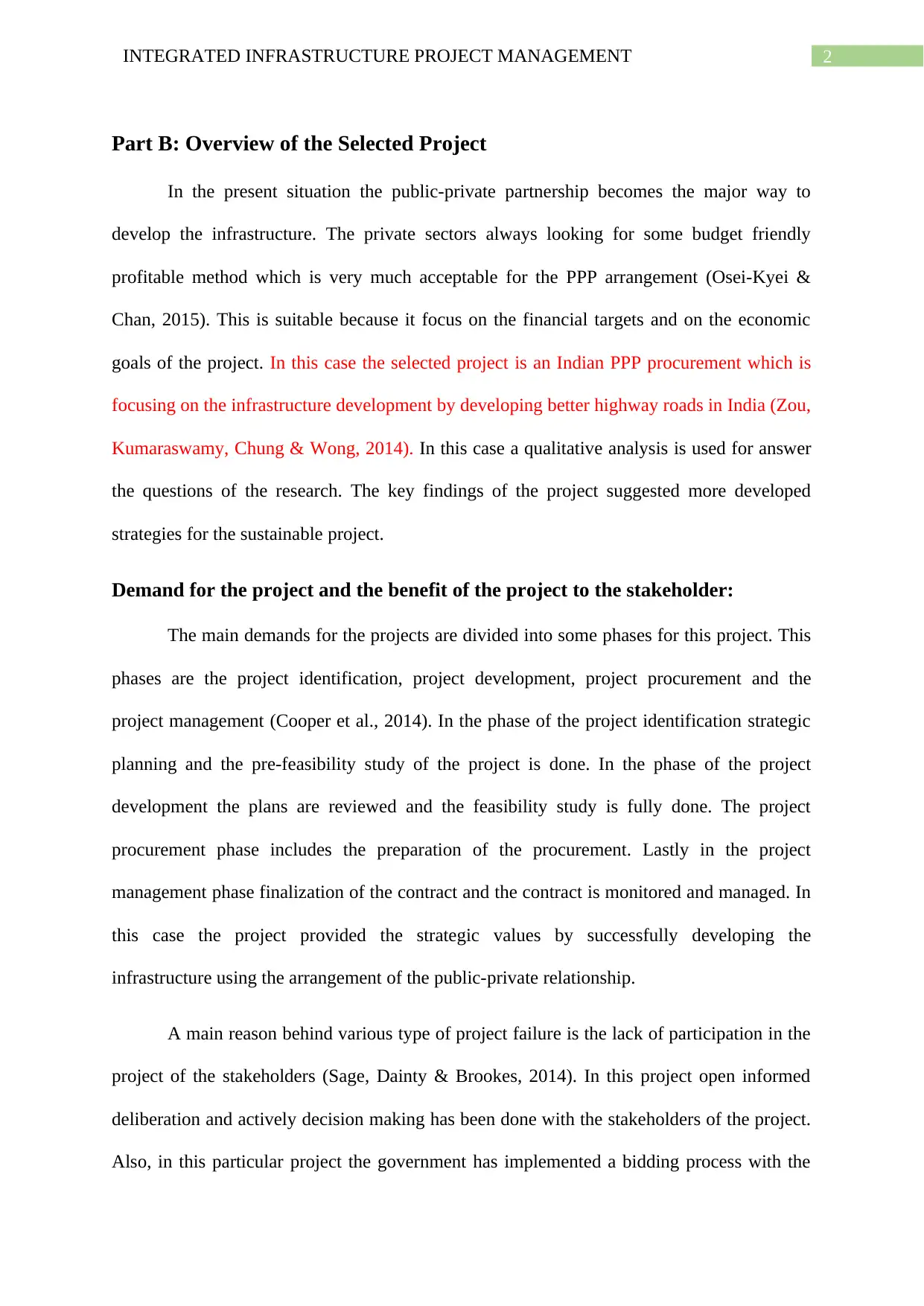
2INTEGRATED INFRASTRUCTURE PROJECT MANAGEMENT
Part B: Overview of the Selected Project
In the present situation the public-private partnership becomes the major way to
develop the infrastructure. The private sectors always looking for some budget friendly
profitable method which is very much acceptable for the PPP arrangement (Osei-Kyei &
Chan, 2015). This is suitable because it focus on the financial targets and on the economic
goals of the project. In this case the selected project is an Indian PPP procurement which is
focusing on the infrastructure development by developing better highway roads in India (Zou,
Kumaraswamy, Chung & Wong, 2014). In this case a qualitative analysis is used for answer
the questions of the research. The key findings of the project suggested more developed
strategies for the sustainable project.
Demand for the project and the benefit of the project to the stakeholder:
The main demands for the projects are divided into some phases for this project. This
phases are the project identification, project development, project procurement and the
project management (Cooper et al., 2014). In the phase of the project identification strategic
planning and the pre-feasibility study of the project is done. In the phase of the project
development the plans are reviewed and the feasibility study is fully done. The project
procurement phase includes the preparation of the procurement. Lastly in the project
management phase finalization of the contract and the contract is monitored and managed. In
this case the project provided the strategic values by successfully developing the
infrastructure using the arrangement of the public-private relationship.
A main reason behind various type of project failure is the lack of participation in the
project of the stakeholders (Sage, Dainty & Brookes, 2014). In this project open informed
deliberation and actively decision making has been done with the stakeholders of the project.
Also, in this particular project the government has implemented a bidding process with the
Part B: Overview of the Selected Project
In the present situation the public-private partnership becomes the major way to
develop the infrastructure. The private sectors always looking for some budget friendly
profitable method which is very much acceptable for the PPP arrangement (Osei-Kyei &
Chan, 2015). This is suitable because it focus on the financial targets and on the economic
goals of the project. In this case the selected project is an Indian PPP procurement which is
focusing on the infrastructure development by developing better highway roads in India (Zou,
Kumaraswamy, Chung & Wong, 2014). In this case a qualitative analysis is used for answer
the questions of the research. The key findings of the project suggested more developed
strategies for the sustainable project.
Demand for the project and the benefit of the project to the stakeholder:
The main demands for the projects are divided into some phases for this project. This
phases are the project identification, project development, project procurement and the
project management (Cooper et al., 2014). In the phase of the project identification strategic
planning and the pre-feasibility study of the project is done. In the phase of the project
development the plans are reviewed and the feasibility study is fully done. The project
procurement phase includes the preparation of the procurement. Lastly in the project
management phase finalization of the contract and the contract is monitored and managed. In
this case the project provided the strategic values by successfully developing the
infrastructure using the arrangement of the public-private relationship.
A main reason behind various type of project failure is the lack of participation in the
project of the stakeholders (Sage, Dainty & Brookes, 2014). In this project open informed
deliberation and actively decision making has been done with the stakeholders of the project.
Also, in this particular project the government has implemented a bidding process with the
⊘ This is a preview!⊘
Do you want full access?
Subscribe today to unlock all pages.

Trusted by 1+ million students worldwide
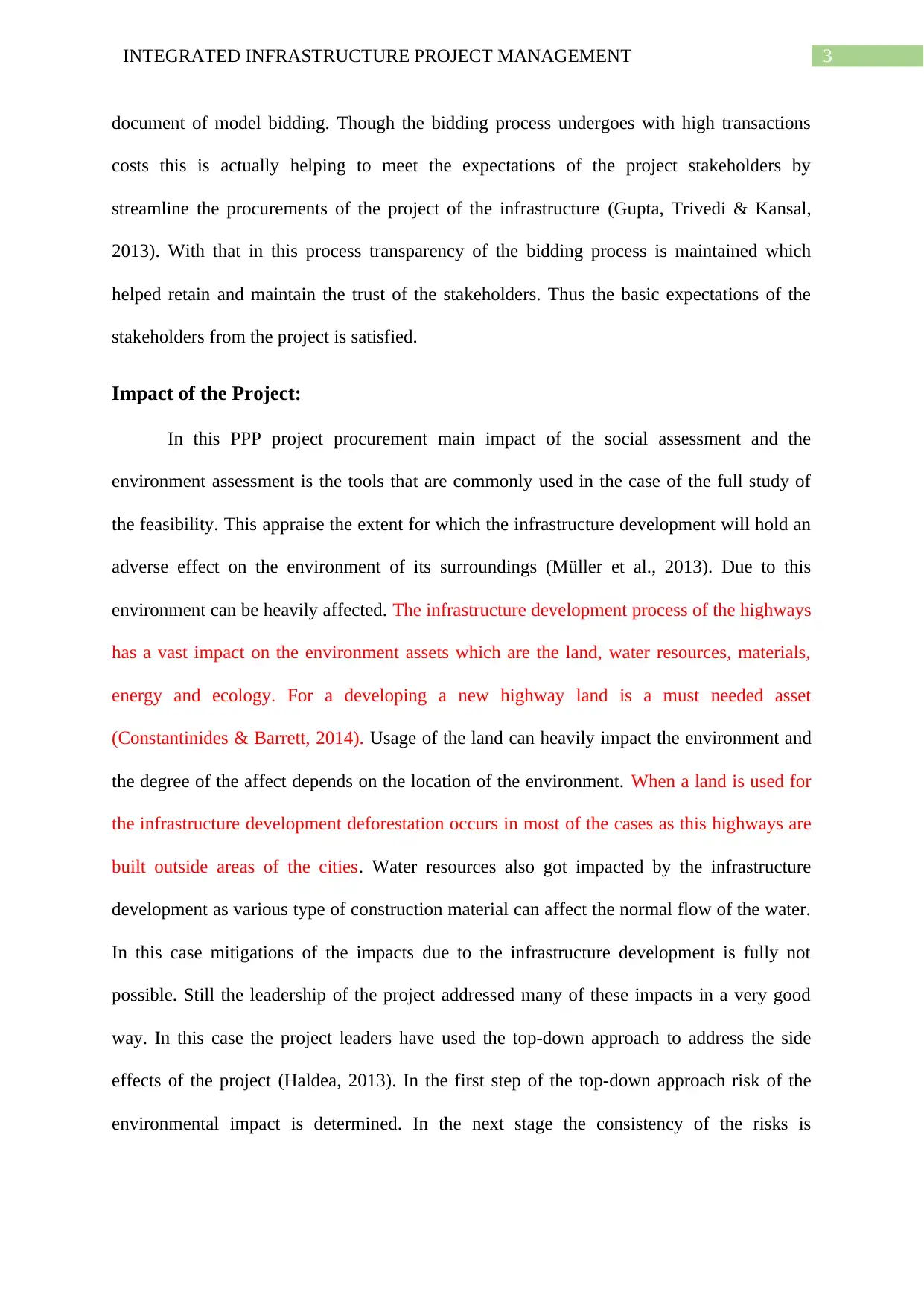
3INTEGRATED INFRASTRUCTURE PROJECT MANAGEMENT
document of model bidding. Though the bidding process undergoes with high transactions
costs this is actually helping to meet the expectations of the project stakeholders by
streamline the procurements of the project of the infrastructure (Gupta, Trivedi & Kansal,
2013). With that in this process transparency of the bidding process is maintained which
helped retain and maintain the trust of the stakeholders. Thus the basic expectations of the
stakeholders from the project is satisfied.
Impact of the Project:
In this PPP project procurement main impact of the social assessment and the
environment assessment is the tools that are commonly used in the case of the full study of
the feasibility. This appraise the extent for which the infrastructure development will hold an
adverse effect on the environment of its surroundings (Müller et al., 2013). Due to this
environment can be heavily affected. The infrastructure development process of the highways
has a vast impact on the environment assets which are the land, water resources, materials,
energy and ecology. For a developing a new highway land is a must needed asset
(Constantinides & Barrett, 2014). Usage of the land can heavily impact the environment and
the degree of the affect depends on the location of the environment. When a land is used for
the infrastructure development deforestation occurs in most of the cases as this highways are
built outside areas of the cities. Water resources also got impacted by the infrastructure
development as various type of construction material can affect the normal flow of the water.
In this case mitigations of the impacts due to the infrastructure development is fully not
possible. Still the leadership of the project addressed many of these impacts in a very good
way. In this case the project leaders have used the top-down approach to address the side
effects of the project (Haldea, 2013). In the first step of the top-down approach risk of the
environmental impact is determined. In the next stage the consistency of the risks is
document of model bidding. Though the bidding process undergoes with high transactions
costs this is actually helping to meet the expectations of the project stakeholders by
streamline the procurements of the project of the infrastructure (Gupta, Trivedi & Kansal,
2013). With that in this process transparency of the bidding process is maintained which
helped retain and maintain the trust of the stakeholders. Thus the basic expectations of the
stakeholders from the project is satisfied.
Impact of the Project:
In this PPP project procurement main impact of the social assessment and the
environment assessment is the tools that are commonly used in the case of the full study of
the feasibility. This appraise the extent for which the infrastructure development will hold an
adverse effect on the environment of its surroundings (Müller et al., 2013). Due to this
environment can be heavily affected. The infrastructure development process of the highways
has a vast impact on the environment assets which are the land, water resources, materials,
energy and ecology. For a developing a new highway land is a must needed asset
(Constantinides & Barrett, 2014). Usage of the land can heavily impact the environment and
the degree of the affect depends on the location of the environment. When a land is used for
the infrastructure development deforestation occurs in most of the cases as this highways are
built outside areas of the cities. Water resources also got impacted by the infrastructure
development as various type of construction material can affect the normal flow of the water.
In this case mitigations of the impacts due to the infrastructure development is fully not
possible. Still the leadership of the project addressed many of these impacts in a very good
way. In this case the project leaders have used the top-down approach to address the side
effects of the project (Haldea, 2013). In the first step of the top-down approach risk of the
environmental impact is determined. In the next stage the consistency of the risks is
Paraphrase This Document
Need a fresh take? Get an instant paraphrase of this document with our AI Paraphraser
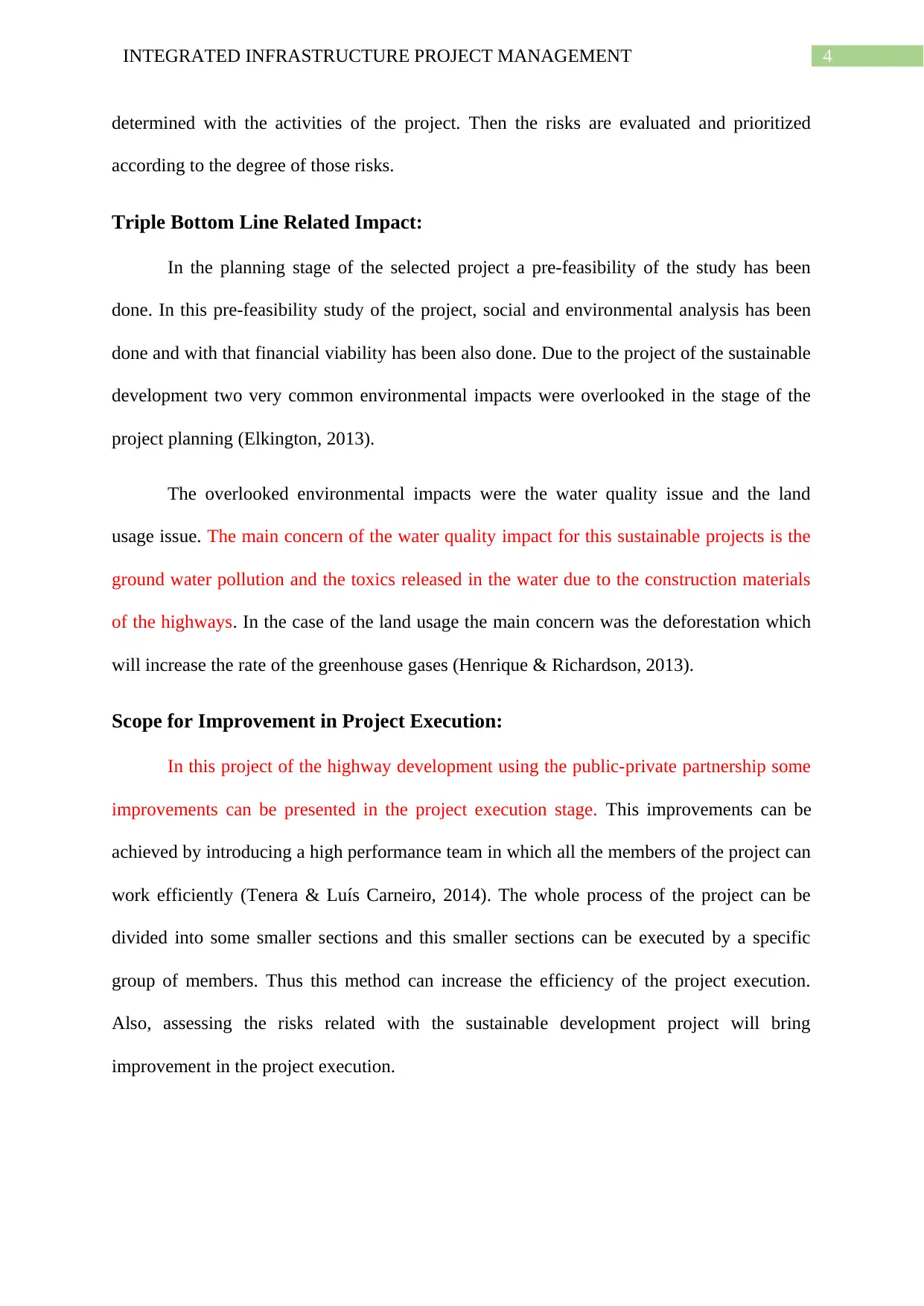
4INTEGRATED INFRASTRUCTURE PROJECT MANAGEMENT
determined with the activities of the project. Then the risks are evaluated and prioritized
according to the degree of those risks.
Triple Bottom Line Related Impact:
In the planning stage of the selected project a pre-feasibility of the study has been
done. In this pre-feasibility study of the project, social and environmental analysis has been
done and with that financial viability has been also done. Due to the project of the sustainable
development two very common environmental impacts were overlooked in the stage of the
project planning (Elkington, 2013).
The overlooked environmental impacts were the water quality issue and the land
usage issue. The main concern of the water quality impact for this sustainable projects is the
ground water pollution and the toxics released in the water due to the construction materials
of the highways. In the case of the land usage the main concern was the deforestation which
will increase the rate of the greenhouse gases (Henrique & Richardson, 2013).
Scope for Improvement in Project Execution:
In this project of the highway development using the public-private partnership some
improvements can be presented in the project execution stage. This improvements can be
achieved by introducing a high performance team in which all the members of the project can
work efficiently (Tenera & Luís Carneiro, 2014). The whole process of the project can be
divided into some smaller sections and this smaller sections can be executed by a specific
group of members. Thus this method can increase the efficiency of the project execution.
Also, assessing the risks related with the sustainable development project will bring
improvement in the project execution.
determined with the activities of the project. Then the risks are evaluated and prioritized
according to the degree of those risks.
Triple Bottom Line Related Impact:
In the planning stage of the selected project a pre-feasibility of the study has been
done. In this pre-feasibility study of the project, social and environmental analysis has been
done and with that financial viability has been also done. Due to the project of the sustainable
development two very common environmental impacts were overlooked in the stage of the
project planning (Elkington, 2013).
The overlooked environmental impacts were the water quality issue and the land
usage issue. The main concern of the water quality impact for this sustainable projects is the
ground water pollution and the toxics released in the water due to the construction materials
of the highways. In the case of the land usage the main concern was the deforestation which
will increase the rate of the greenhouse gases (Henrique & Richardson, 2013).
Scope for Improvement in Project Execution:
In this project of the highway development using the public-private partnership some
improvements can be presented in the project execution stage. This improvements can be
achieved by introducing a high performance team in which all the members of the project can
work efficiently (Tenera & Luís Carneiro, 2014). The whole process of the project can be
divided into some smaller sections and this smaller sections can be executed by a specific
group of members. Thus this method can increase the efficiency of the project execution.
Also, assessing the risks related with the sustainable development project will bring
improvement in the project execution.
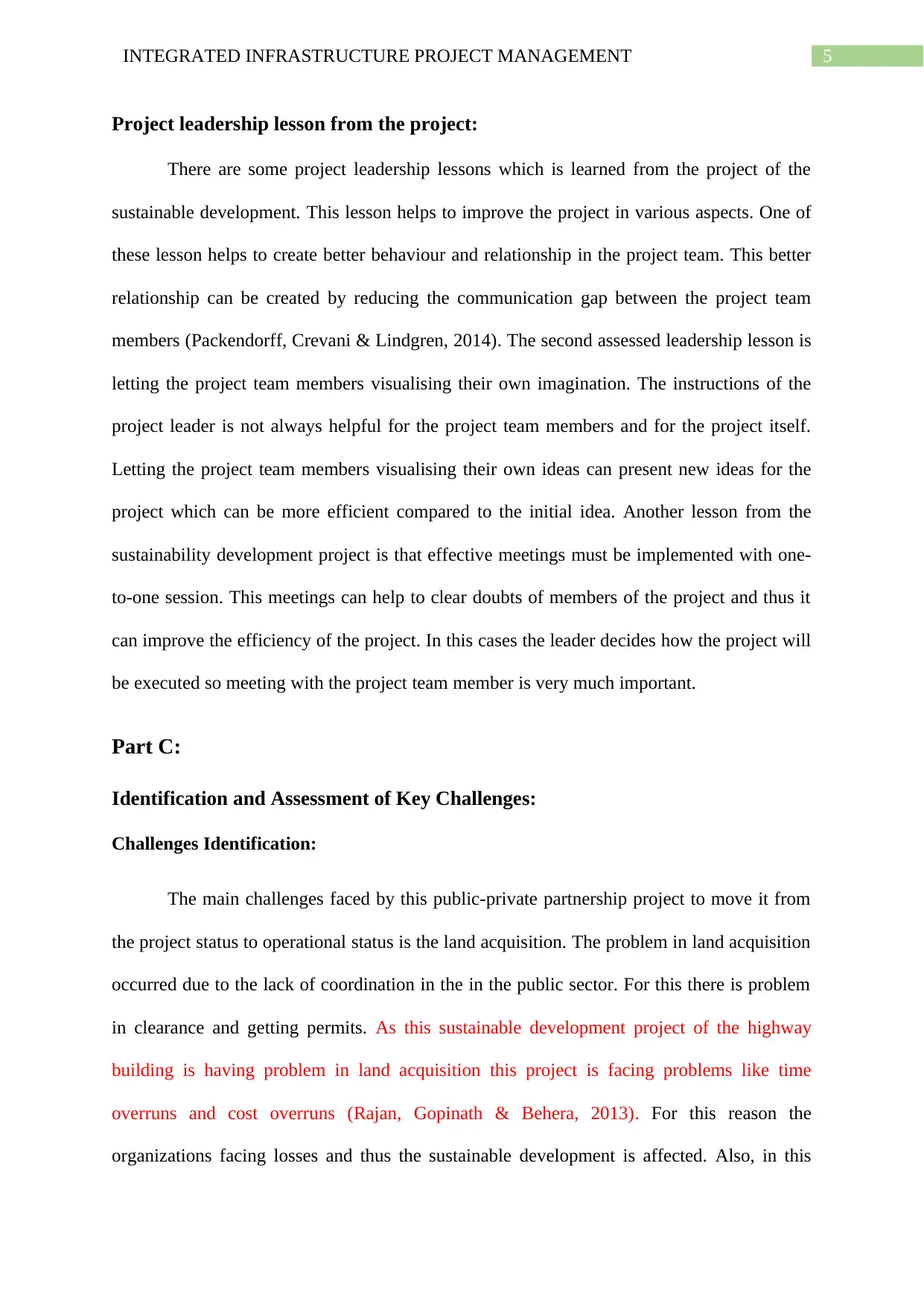
5INTEGRATED INFRASTRUCTURE PROJECT MANAGEMENT
Project leadership lesson from the project:
There are some project leadership lessons which is learned from the project of the
sustainable development. This lesson helps to improve the project in various aspects. One of
these lesson helps to create better behaviour and relationship in the project team. This better
relationship can be created by reducing the communication gap between the project team
members (Packendorff, Crevani & Lindgren, 2014). The second assessed leadership lesson is
letting the project team members visualising their own imagination. The instructions of the
project leader is not always helpful for the project team members and for the project itself.
Letting the project team members visualising their own ideas can present new ideas for the
project which can be more efficient compared to the initial idea. Another lesson from the
sustainability development project is that effective meetings must be implemented with one-
to-one session. This meetings can help to clear doubts of members of the project and thus it
can improve the efficiency of the project. In this cases the leader decides how the project will
be executed so meeting with the project team member is very much important.
Part C:
Identification and Assessment of Key Challenges:
Challenges Identification:
The main challenges faced by this public-private partnership project to move it from
the project status to operational status is the land acquisition. The problem in land acquisition
occurred due to the lack of coordination in the in the public sector. For this there is problem
in clearance and getting permits. As this sustainable development project of the highway
building is having problem in land acquisition this project is facing problems like time
overruns and cost overruns (Rajan, Gopinath & Behera, 2013). For this reason the
organizations facing losses and thus the sustainable development is affected. Also, in this
Project leadership lesson from the project:
There are some project leadership lessons which is learned from the project of the
sustainable development. This lesson helps to improve the project in various aspects. One of
these lesson helps to create better behaviour and relationship in the project team. This better
relationship can be created by reducing the communication gap between the project team
members (Packendorff, Crevani & Lindgren, 2014). The second assessed leadership lesson is
letting the project team members visualising their own imagination. The instructions of the
project leader is not always helpful for the project team members and for the project itself.
Letting the project team members visualising their own ideas can present new ideas for the
project which can be more efficient compared to the initial idea. Another lesson from the
sustainability development project is that effective meetings must be implemented with one-
to-one session. This meetings can help to clear doubts of members of the project and thus it
can improve the efficiency of the project. In this cases the leader decides how the project will
be executed so meeting with the project team member is very much important.
Part C:
Identification and Assessment of Key Challenges:
Challenges Identification:
The main challenges faced by this public-private partnership project to move it from
the project status to operational status is the land acquisition. The problem in land acquisition
occurred due to the lack of coordination in the in the public sector. For this there is problem
in clearance and getting permits. As this sustainable development project of the highway
building is having problem in land acquisition this project is facing problems like time
overruns and cost overruns (Rajan, Gopinath & Behera, 2013). For this reason the
organizations facing losses and thus the sustainable development is affected. Also, in this
⊘ This is a preview!⊘
Do you want full access?
Subscribe today to unlock all pages.

Trusted by 1+ million students worldwide
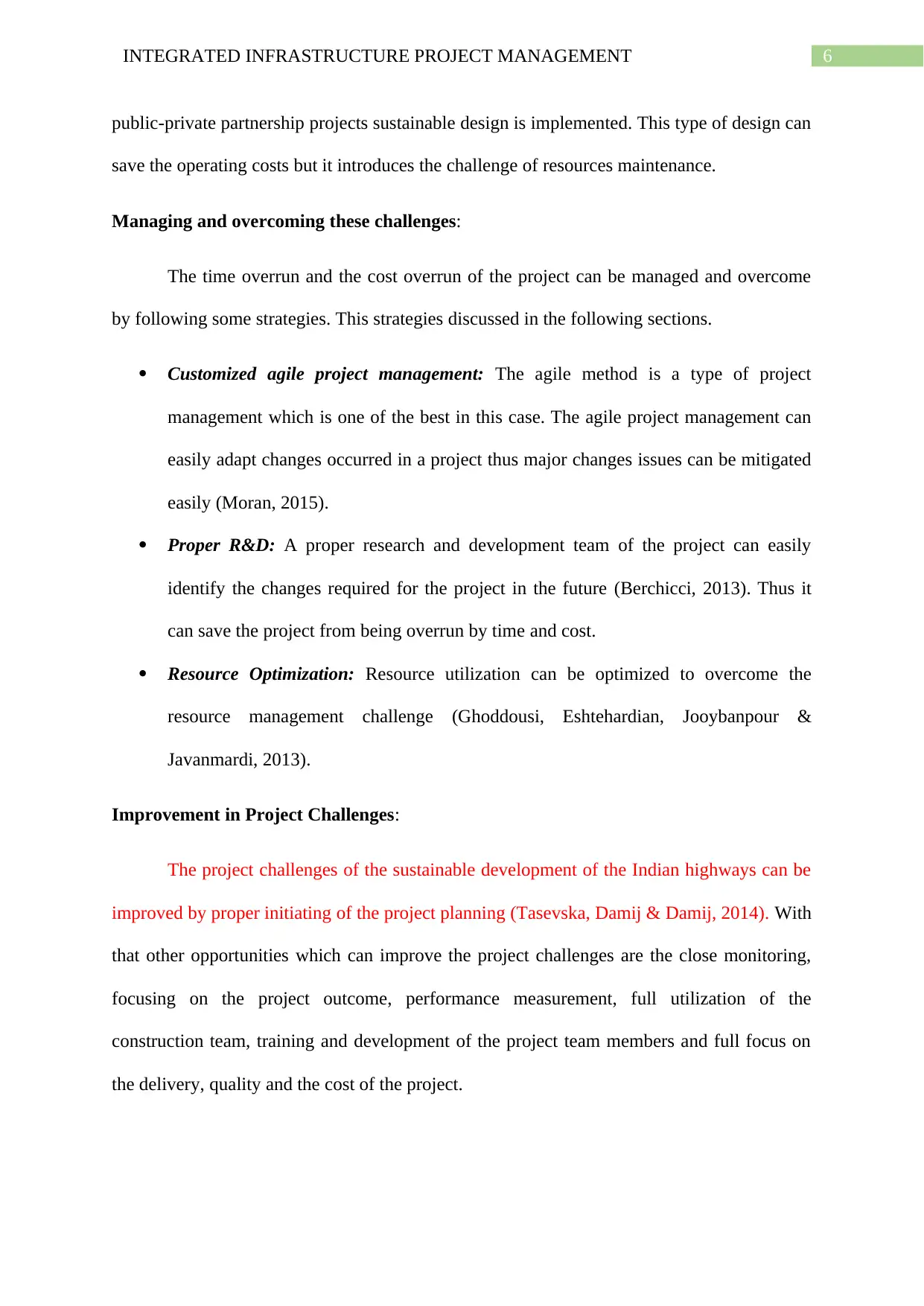
6INTEGRATED INFRASTRUCTURE PROJECT MANAGEMENT
public-private partnership projects sustainable design is implemented. This type of design can
save the operating costs but it introduces the challenge of resources maintenance.
Managing and overcoming these challenges:
The time overrun and the cost overrun of the project can be managed and overcome
by following some strategies. This strategies discussed in the following sections.
Customized agile project management: The agile method is a type of project
management which is one of the best in this case. The agile project management can
easily adapt changes occurred in a project thus major changes issues can be mitigated
easily (Moran, 2015).
Proper R&D: A proper research and development team of the project can easily
identify the changes required for the project in the future (Berchicci, 2013). Thus it
can save the project from being overrun by time and cost.
Resource Optimization: Resource utilization can be optimized to overcome the
resource management challenge (Ghoddousi, Eshtehardian, Jooybanpour &
Javanmardi, 2013).
Improvement in Project Challenges:
The project challenges of the sustainable development of the Indian highways can be
improved by proper initiating of the project planning (Tasevska, Damij & Damij, 2014). With
that other opportunities which can improve the project challenges are the close monitoring,
focusing on the project outcome, performance measurement, full utilization of the
construction team, training and development of the project team members and full focus on
the delivery, quality and the cost of the project.
public-private partnership projects sustainable design is implemented. This type of design can
save the operating costs but it introduces the challenge of resources maintenance.
Managing and overcoming these challenges:
The time overrun and the cost overrun of the project can be managed and overcome
by following some strategies. This strategies discussed in the following sections.
Customized agile project management: The agile method is a type of project
management which is one of the best in this case. The agile project management can
easily adapt changes occurred in a project thus major changes issues can be mitigated
easily (Moran, 2015).
Proper R&D: A proper research and development team of the project can easily
identify the changes required for the project in the future (Berchicci, 2013). Thus it
can save the project from being overrun by time and cost.
Resource Optimization: Resource utilization can be optimized to overcome the
resource management challenge (Ghoddousi, Eshtehardian, Jooybanpour &
Javanmardi, 2013).
Improvement in Project Challenges:
The project challenges of the sustainable development of the Indian highways can be
improved by proper initiating of the project planning (Tasevska, Damij & Damij, 2014). With
that other opportunities which can improve the project challenges are the close monitoring,
focusing on the project outcome, performance measurement, full utilization of the
construction team, training and development of the project team members and full focus on
the delivery, quality and the cost of the project.
Paraphrase This Document
Need a fresh take? Get an instant paraphrase of this document with our AI Paraphraser
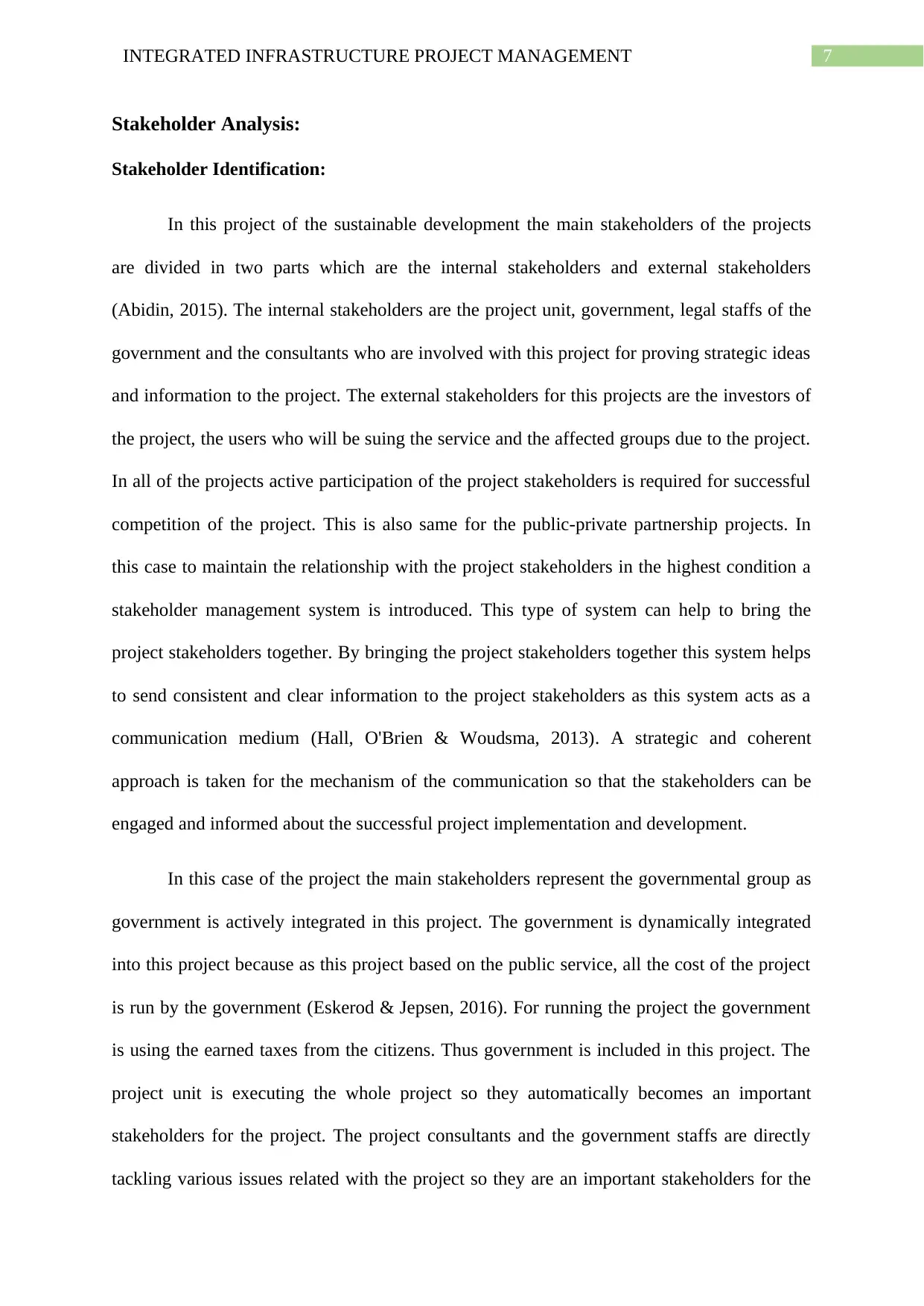
7INTEGRATED INFRASTRUCTURE PROJECT MANAGEMENT
Stakeholder Analysis:
Stakeholder Identification:
In this project of the sustainable development the main stakeholders of the projects
are divided in two parts which are the internal stakeholders and external stakeholders
(Abidin, 2015). The internal stakeholders are the project unit, government, legal staffs of the
government and the consultants who are involved with this project for proving strategic ideas
and information to the project. The external stakeholders for this projects are the investors of
the project, the users who will be suing the service and the affected groups due to the project.
In all of the projects active participation of the project stakeholders is required for successful
competition of the project. This is also same for the public-private partnership projects. In
this case to maintain the relationship with the project stakeholders in the highest condition a
stakeholder management system is introduced. This type of system can help to bring the
project stakeholders together. By bringing the project stakeholders together this system helps
to send consistent and clear information to the project stakeholders as this system acts as a
communication medium (Hall, O'Brien & Woudsma, 2013). A strategic and coherent
approach is taken for the mechanism of the communication so that the stakeholders can be
engaged and informed about the successful project implementation and development.
In this case of the project the main stakeholders represent the governmental group as
government is actively integrated in this project. The government is dynamically integrated
into this project because as this project based on the public service, all the cost of the project
is run by the government (Eskerod & Jepsen, 2016). For running the project the government
is using the earned taxes from the citizens. Thus government is included in this project. The
project unit is executing the whole project so they automatically becomes an important
stakeholders for the project. The project consultants and the government staffs are directly
tackling various issues related with the project so they are an important stakeholders for the
Stakeholder Analysis:
Stakeholder Identification:
In this project of the sustainable development the main stakeholders of the projects
are divided in two parts which are the internal stakeholders and external stakeholders
(Abidin, 2015). The internal stakeholders are the project unit, government, legal staffs of the
government and the consultants who are involved with this project for proving strategic ideas
and information to the project. The external stakeholders for this projects are the investors of
the project, the users who will be suing the service and the affected groups due to the project.
In all of the projects active participation of the project stakeholders is required for successful
competition of the project. This is also same for the public-private partnership projects. In
this case to maintain the relationship with the project stakeholders in the highest condition a
stakeholder management system is introduced. This type of system can help to bring the
project stakeholders together. By bringing the project stakeholders together this system helps
to send consistent and clear information to the project stakeholders as this system acts as a
communication medium (Hall, O'Brien & Woudsma, 2013). A strategic and coherent
approach is taken for the mechanism of the communication so that the stakeholders can be
engaged and informed about the successful project implementation and development.
In this case of the project the main stakeholders represent the governmental group as
government is actively integrated in this project. The government is dynamically integrated
into this project because as this project based on the public service, all the cost of the project
is run by the government (Eskerod & Jepsen, 2016). For running the project the government
is using the earned taxes from the citizens. Thus government is included in this project. The
project unit is executing the whole project so they automatically becomes an important
stakeholders for the project. The project consultants and the government staffs are directly
tackling various issues related with the project so they are an important stakeholders for the
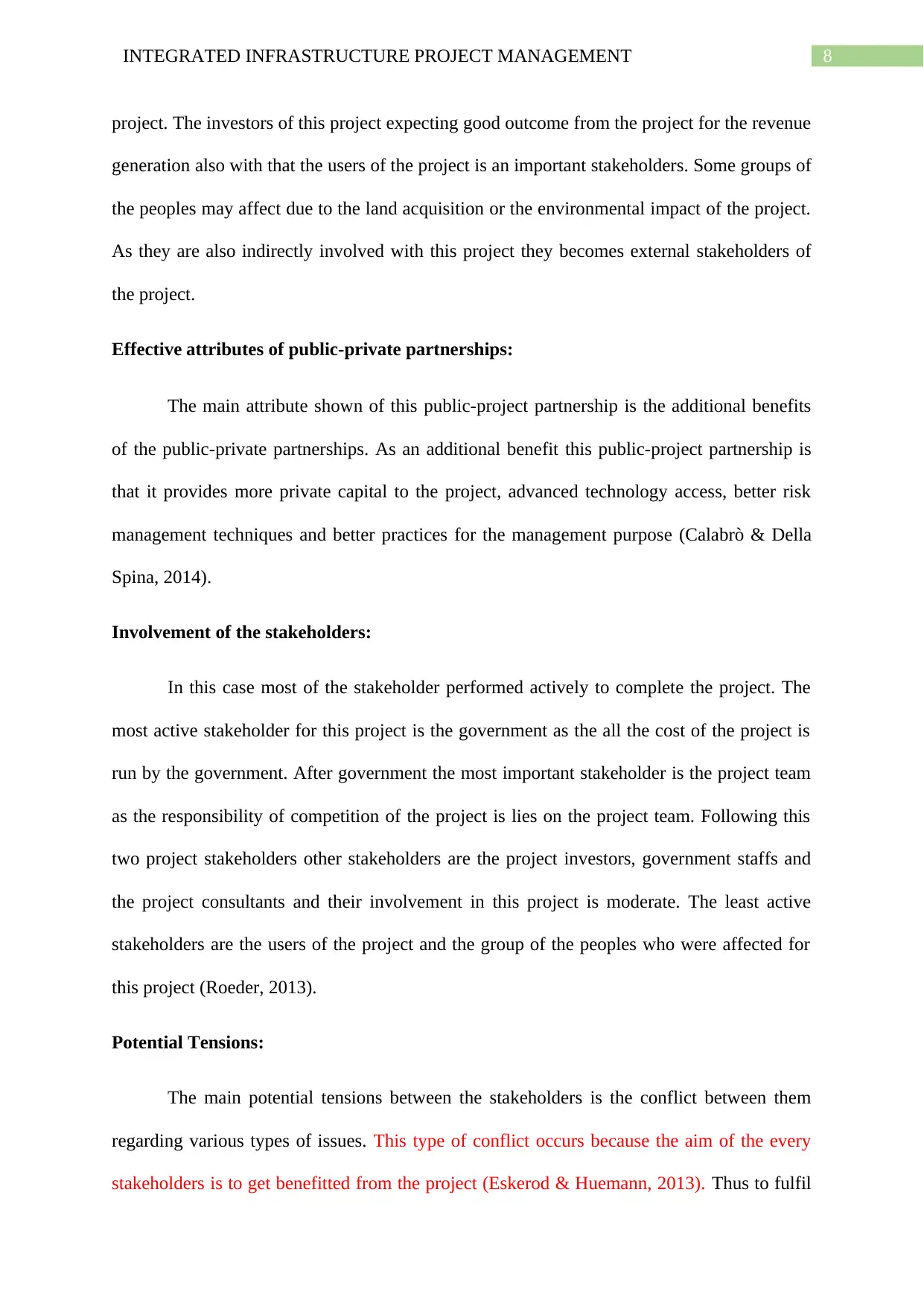
8INTEGRATED INFRASTRUCTURE PROJECT MANAGEMENT
project. The investors of this project expecting good outcome from the project for the revenue
generation also with that the users of the project is an important stakeholders. Some groups of
the peoples may affect due to the land acquisition or the environmental impact of the project.
As they are also indirectly involved with this project they becomes external stakeholders of
the project.
Effective attributes of public-private partnerships:
The main attribute shown of this public-project partnership is the additional benefits
of the public-private partnerships. As an additional benefit this public-project partnership is
that it provides more private capital to the project, advanced technology access, better risk
management techniques and better practices for the management purpose (Calabrò & Della
Spina, 2014).
Involvement of the stakeholders:
In this case most of the stakeholder performed actively to complete the project. The
most active stakeholder for this project is the government as the all the cost of the project is
run by the government. After government the most important stakeholder is the project team
as the responsibility of competition of the project is lies on the project team. Following this
two project stakeholders other stakeholders are the project investors, government staffs and
the project consultants and their involvement in this project is moderate. The least active
stakeholders are the users of the project and the group of the peoples who were affected for
this project (Roeder, 2013).
Potential Tensions:
The main potential tensions between the stakeholders is the conflict between them
regarding various types of issues. This type of conflict occurs because the aim of the every
stakeholders is to get benefitted from the project (Eskerod & Huemann, 2013). Thus to fulfil
project. The investors of this project expecting good outcome from the project for the revenue
generation also with that the users of the project is an important stakeholders. Some groups of
the peoples may affect due to the land acquisition or the environmental impact of the project.
As they are also indirectly involved with this project they becomes external stakeholders of
the project.
Effective attributes of public-private partnerships:
The main attribute shown of this public-project partnership is the additional benefits
of the public-private partnerships. As an additional benefit this public-project partnership is
that it provides more private capital to the project, advanced technology access, better risk
management techniques and better practices for the management purpose (Calabrò & Della
Spina, 2014).
Involvement of the stakeholders:
In this case most of the stakeholder performed actively to complete the project. The
most active stakeholder for this project is the government as the all the cost of the project is
run by the government. After government the most important stakeholder is the project team
as the responsibility of competition of the project is lies on the project team. Following this
two project stakeholders other stakeholders are the project investors, government staffs and
the project consultants and their involvement in this project is moderate. The least active
stakeholders are the users of the project and the group of the peoples who were affected for
this project (Roeder, 2013).
Potential Tensions:
The main potential tensions between the stakeholders is the conflict between them
regarding various types of issues. This type of conflict occurs because the aim of the every
stakeholders is to get benefitted from the project (Eskerod & Huemann, 2013). Thus to fulfil
⊘ This is a preview!⊘
Do you want full access?
Subscribe today to unlock all pages.

Trusted by 1+ million students worldwide
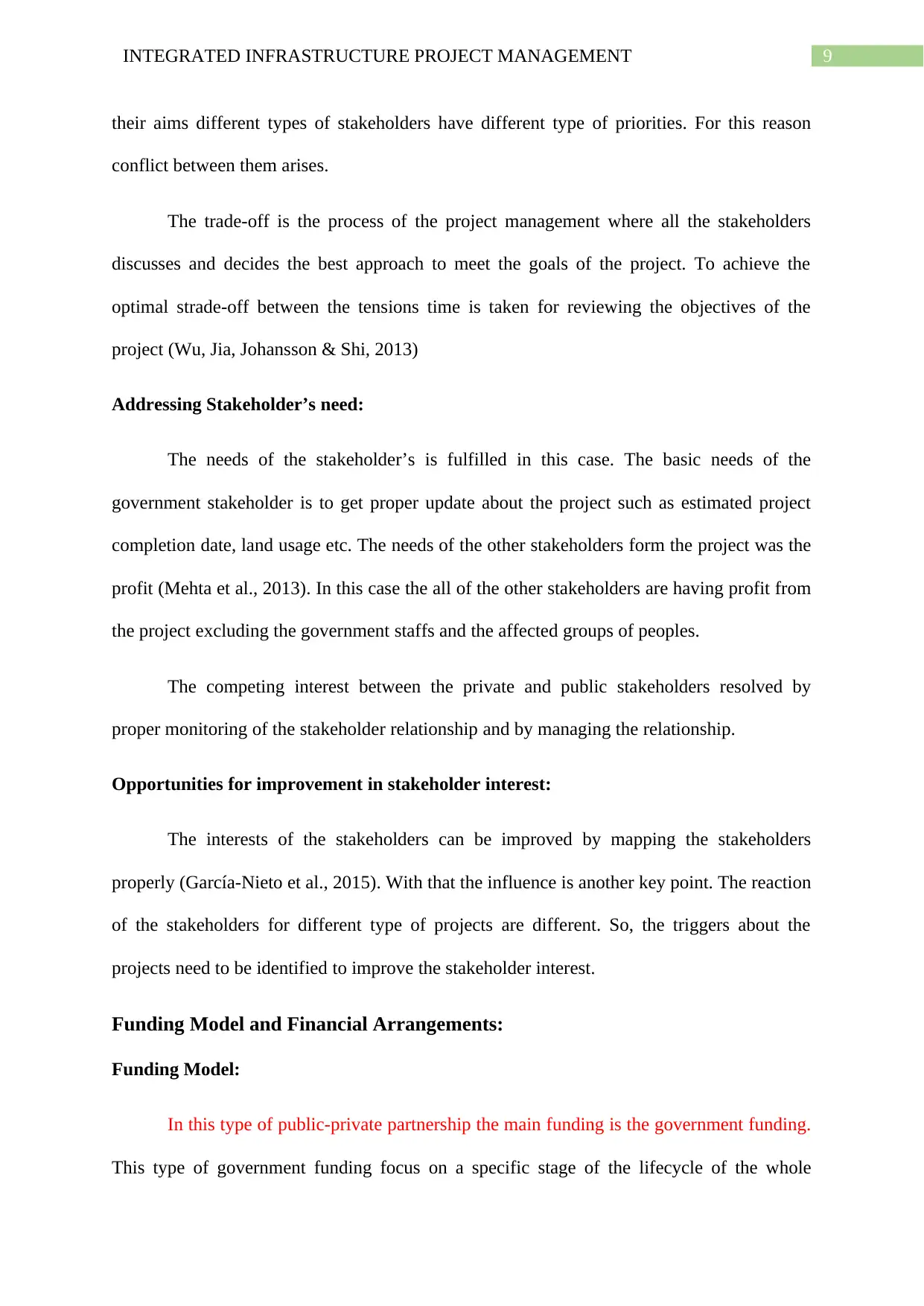
9INTEGRATED INFRASTRUCTURE PROJECT MANAGEMENT
their aims different types of stakeholders have different type of priorities. For this reason
conflict between them arises.
The trade-off is the process of the project management where all the stakeholders
discusses and decides the best approach to meet the goals of the project. To achieve the
optimal strade-off between the tensions time is taken for reviewing the objectives of the
project (Wu, Jia, Johansson & Shi, 2013)
Addressing Stakeholder’s need:
The needs of the stakeholder’s is fulfilled in this case. The basic needs of the
government stakeholder is to get proper update about the project such as estimated project
completion date, land usage etc. The needs of the other stakeholders form the project was the
profit (Mehta et al., 2013). In this case the all of the other stakeholders are having profit from
the project excluding the government staffs and the affected groups of peoples.
The competing interest between the private and public stakeholders resolved by
proper monitoring of the stakeholder relationship and by managing the relationship.
Opportunities for improvement in stakeholder interest:
The interests of the stakeholders can be improved by mapping the stakeholders
properly (García-Nieto et al., 2015). With that the influence is another key point. The reaction
of the stakeholders for different type of projects are different. So, the triggers about the
projects need to be identified to improve the stakeholder interest.
Funding Model and Financial Arrangements:
Funding Model:
In this type of public-private partnership the main funding is the government funding.
This type of government funding focus on a specific stage of the lifecycle of the whole
their aims different types of stakeholders have different type of priorities. For this reason
conflict between them arises.
The trade-off is the process of the project management where all the stakeholders
discusses and decides the best approach to meet the goals of the project. To achieve the
optimal strade-off between the tensions time is taken for reviewing the objectives of the
project (Wu, Jia, Johansson & Shi, 2013)
Addressing Stakeholder’s need:
The needs of the stakeholder’s is fulfilled in this case. The basic needs of the
government stakeholder is to get proper update about the project such as estimated project
completion date, land usage etc. The needs of the other stakeholders form the project was the
profit (Mehta et al., 2013). In this case the all of the other stakeholders are having profit from
the project excluding the government staffs and the affected groups of peoples.
The competing interest between the private and public stakeholders resolved by
proper monitoring of the stakeholder relationship and by managing the relationship.
Opportunities for improvement in stakeholder interest:
The interests of the stakeholders can be improved by mapping the stakeholders
properly (García-Nieto et al., 2015). With that the influence is another key point. The reaction
of the stakeholders for different type of projects are different. So, the triggers about the
projects need to be identified to improve the stakeholder interest.
Funding Model and Financial Arrangements:
Funding Model:
In this type of public-private partnership the main funding is the government funding.
This type of government funding focus on a specific stage of the lifecycle of the whole
Paraphrase This Document
Need a fresh take? Get an instant paraphrase of this document with our AI Paraphraser
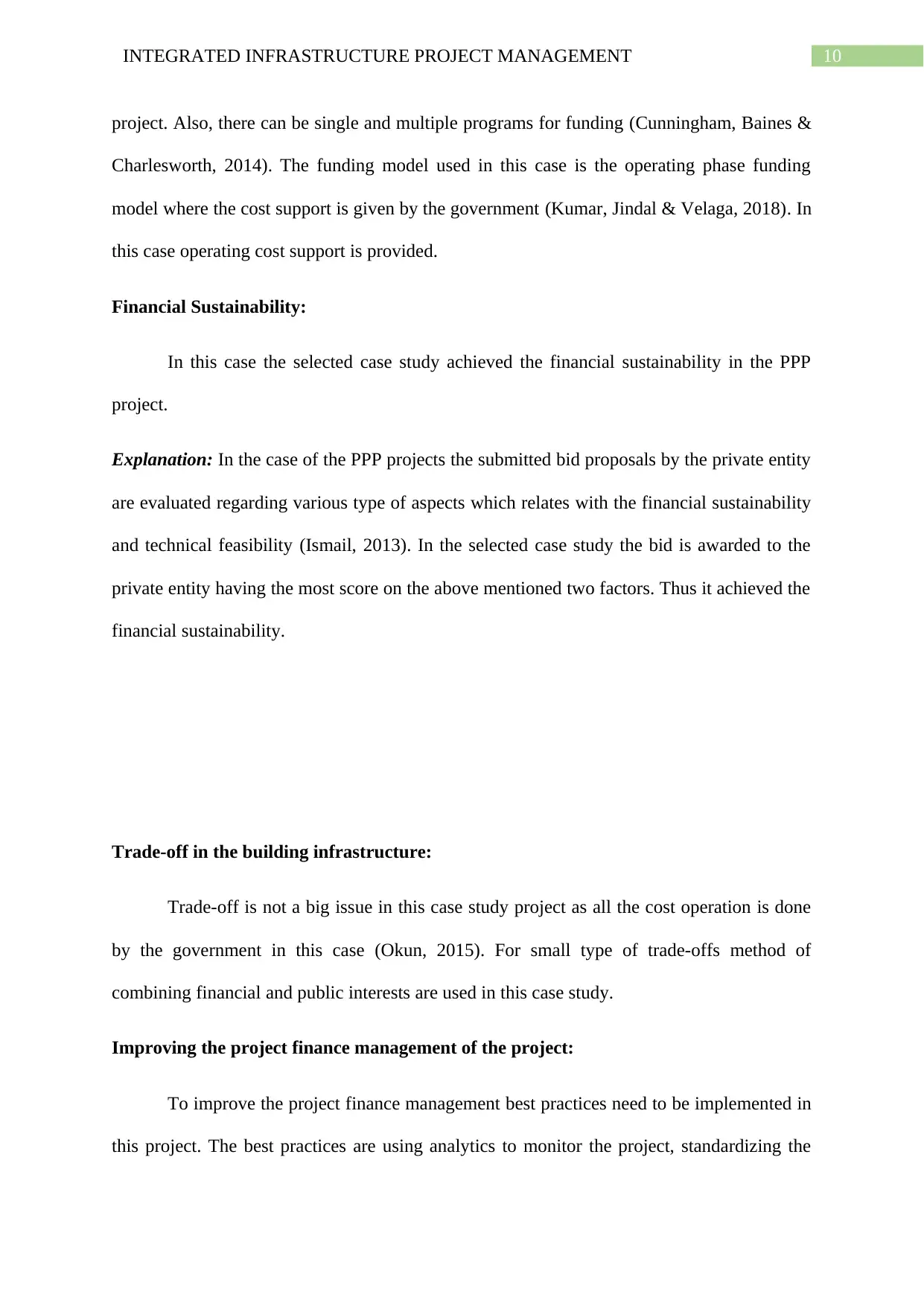
10INTEGRATED INFRASTRUCTURE PROJECT MANAGEMENT
project. Also, there can be single and multiple programs for funding (Cunningham, Baines &
Charlesworth, 2014). The funding model used in this case is the operating phase funding
model where the cost support is given by the government (Kumar, Jindal & Velaga, 2018). In
this case operating cost support is provided.
Financial Sustainability:
In this case the selected case study achieved the financial sustainability in the PPP
project.
Explanation: In the case of the PPP projects the submitted bid proposals by the private entity
are evaluated regarding various type of aspects which relates with the financial sustainability
and technical feasibility (Ismail, 2013). In the selected case study the bid is awarded to the
private entity having the most score on the above mentioned two factors. Thus it achieved the
financial sustainability.
Trade-off in the building infrastructure:
Trade-off is not a big issue in this case study project as all the cost operation is done
by the government in this case (Okun, 2015). For small type of trade-offs method of
combining financial and public interests are used in this case study.
Improving the project finance management of the project:
To improve the project finance management best practices need to be implemented in
this project. The best practices are using analytics to monitor the project, standardizing the
project. Also, there can be single and multiple programs for funding (Cunningham, Baines &
Charlesworth, 2014). The funding model used in this case is the operating phase funding
model where the cost support is given by the government (Kumar, Jindal & Velaga, 2018). In
this case operating cost support is provided.
Financial Sustainability:
In this case the selected case study achieved the financial sustainability in the PPP
project.
Explanation: In the case of the PPP projects the submitted bid proposals by the private entity
are evaluated regarding various type of aspects which relates with the financial sustainability
and technical feasibility (Ismail, 2013). In the selected case study the bid is awarded to the
private entity having the most score on the above mentioned two factors. Thus it achieved the
financial sustainability.
Trade-off in the building infrastructure:
Trade-off is not a big issue in this case study project as all the cost operation is done
by the government in this case (Okun, 2015). For small type of trade-offs method of
combining financial and public interests are used in this case study.
Improving the project finance management of the project:
To improve the project finance management best practices need to be implemented in
this project. The best practices are using analytics to monitor the project, standardizing the
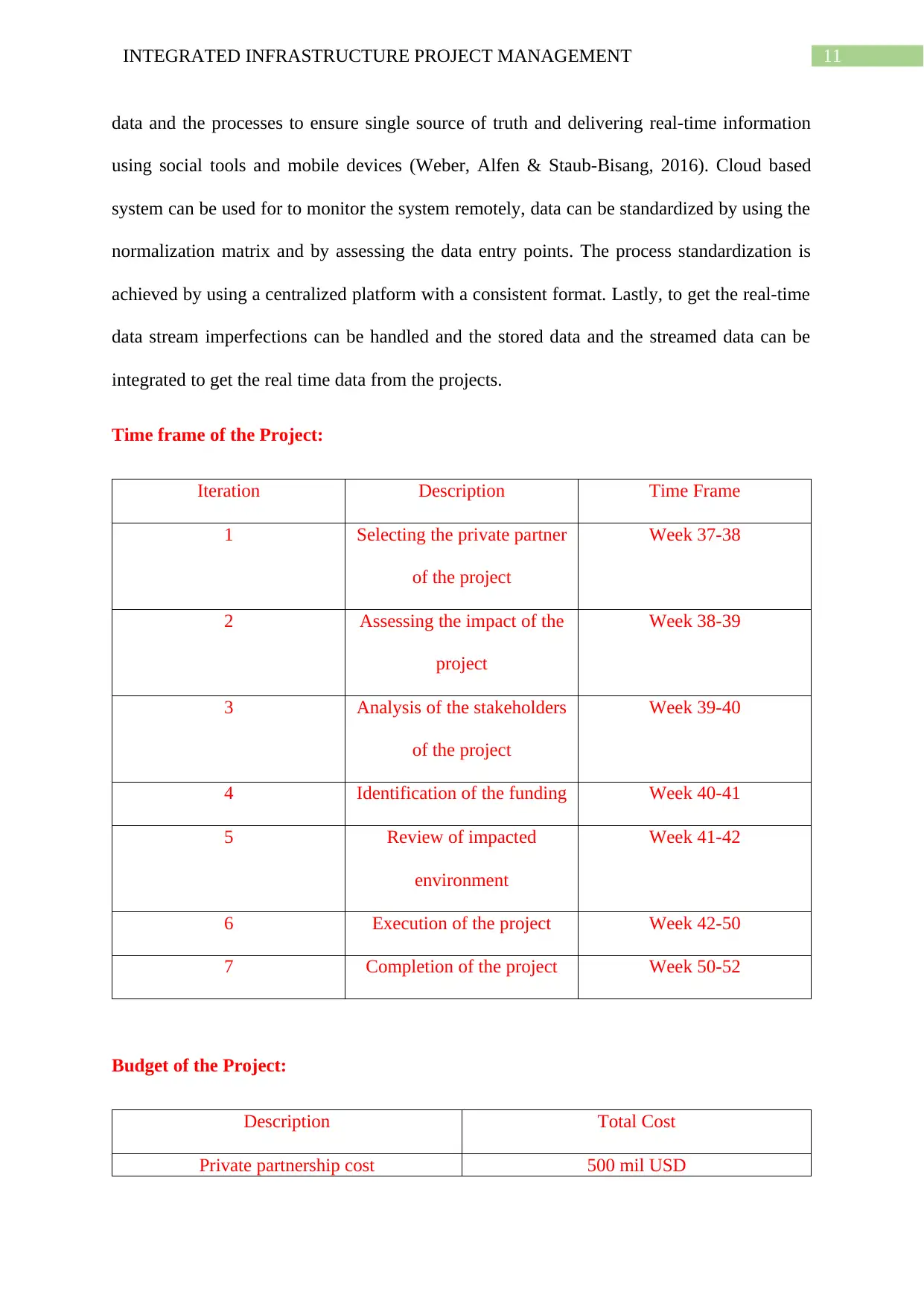
11INTEGRATED INFRASTRUCTURE PROJECT MANAGEMENT
data and the processes to ensure single source of truth and delivering real-time information
using social tools and mobile devices (Weber, Alfen & Staub-Bisang, 2016). Cloud based
system can be used for to monitor the system remotely, data can be standardized by using the
normalization matrix and by assessing the data entry points. The process standardization is
achieved by using a centralized platform with a consistent format. Lastly, to get the real-time
data stream imperfections can be handled and the stored data and the streamed data can be
integrated to get the real time data from the projects.
Time frame of the Project:
Iteration Description Time Frame
1 Selecting the private partner
of the project
Week 37-38
2 Assessing the impact of the
project
Week 38-39
3 Analysis of the stakeholders
of the project
Week 39-40
4 Identification of the funding Week 40-41
5 Review of impacted
environment
Week 41-42
6 Execution of the project Week 42-50
7 Completion of the project Week 50-52
Budget of the Project:
Description Total Cost
Private partnership cost 500 mil USD
data and the processes to ensure single source of truth and delivering real-time information
using social tools and mobile devices (Weber, Alfen & Staub-Bisang, 2016). Cloud based
system can be used for to monitor the system remotely, data can be standardized by using the
normalization matrix and by assessing the data entry points. The process standardization is
achieved by using a centralized platform with a consistent format. Lastly, to get the real-time
data stream imperfections can be handled and the stored data and the streamed data can be
integrated to get the real time data from the projects.
Time frame of the Project:
Iteration Description Time Frame
1 Selecting the private partner
of the project
Week 37-38
2 Assessing the impact of the
project
Week 38-39
3 Analysis of the stakeholders
of the project
Week 39-40
4 Identification of the funding Week 40-41
5 Review of impacted
environment
Week 41-42
6 Execution of the project Week 42-50
7 Completion of the project Week 50-52
Budget of the Project:
Description Total Cost
Private partnership cost 500 mil USD
⊘ This is a preview!⊘
Do you want full access?
Subscribe today to unlock all pages.

Trusted by 1+ million students worldwide
1 out of 18
Related Documents
Your All-in-One AI-Powered Toolkit for Academic Success.
+13062052269
info@desklib.com
Available 24*7 on WhatsApp / Email
![[object Object]](/_next/static/media/star-bottom.7253800d.svg)
Unlock your academic potential
Copyright © 2020–2025 A2Z Services. All Rights Reserved. Developed and managed by ZUCOL.





